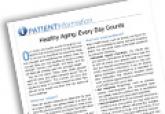Patient Information

Healthy Aging: Every Day Counts
Our minds and bodies evolve throughout our lifetime, but knowing what is normal and what is not can be important for preventing negative changes...
Between 2015 and 2020, for the first time, globally, the percentage of people aged ≥ 65 years will surpass the percentage of the very young (aged ≤ 4 years). It is an unprecedented event called “the crossing,” discussed in a special report, 65+ in the United States: 2010, commissioned by the NIH. Drawing on data from the 2010 U.S. census and other nationally representative surveys, the report covers a range of topics, from health to economic characteristics, to where most of the older people are living and moving to (the West and the South remain the most popular), down to their use of the Internet and voting habits.
What will that momentous shift mean for health care? The report aims to both anticipate and answer that question. Here are some of the highlights—and implications—of the data.
Rates of smoking and drinking among adults aged ≥ 65 years have declined, but rates of overweight and obese have increased. Between 2003 and 2006, 72% of men and 67% of women aged ≥ 65 years were overweight or obese. That’s one reason why rates of a variety of chronic diseases have increased in this age group. High blood pressure, heart disease, chronic lung disease, and diabetes increased between 1998 and 2008. In 2008, 41% of the older population had ≥ 3 chronic conditions, 51% had < 3. Only 8% had no chronic conditions. Moreover, more than one-third of Americans had ≥ 1 disability, most commonly affecting walking, climbing stairs, and doing errands alone. According to census data, about 50% of people aged ≥ 65 years have physical limitations, mostly caused by arthritis and other musculoskeletal disorders.
Life expectancy is still on the rise, the report says, and death rates have declined “dramatically.” The report expands on previous reports by more thoroughly discussing long-term care, nursing homes, and in-home care, including the impact the recent 2007-2009 recession had on older Americans. Skilled nursing facilities have been losing their share of patients, down from 4.5% in 2000 to 3.1% in 2010, while other long-term care facilities, such as assisted living, have been growing. Medicaid funds for long-term care have been shifting away from nursing homes, while funding for home- and community-based services has risen from 13% of total funding in 1990 to 43% in 2007. As the report points out, Medicaid can provide home- and community-based services to 3 people for the same cost as 1 patient in a nursing home.
Getting older has changed, and health care will need to change as well. Although many older people have chronic diseases or disabilities, not all do. Most (61%) older adults living in the traditional community (eg, in their own home) have no functional limitations, compared with 68% of adults in long-term care facilities, who have ≥ 3 activities of daily living (ADL) limitations. And now there’s a new generation of products designed to make getting around during older age easier. Assistive devices can help people stay in their homes longer—canes to help with mobility, shower benches for independent bathing, and other tools reduce the need for outside help. In the 1990s, the report notes, the proportion of chronically disabled older adults with ADL or instrumental ADL problems who were able to manage with only assistive devices rose, while use of personal care assistants declined.
Technology also can be an assistive device. Computer programs and electronic devices make it possible for adults with vision problems to read, and modified phones and appliances can help people with cognitive impairment or arthritis. And the report adds, the field of telemedicine can help patients receive health care in their homes.
Still, no matter how healthy baby boomers are as they age, there are a lot of them. An estimated 83.7 million people will be aged ≥ 65 years by 2050—one-fifth the U.S. population. And as in so many areas, they’re breaking new ground, including in how they’re cared for. Richard Suzman, director of the Division of Behavioral and Social Research at the National Institute on Aging, predicts “an approaching crisis in caregiving,” because the baby boomers had fewer children compared with their parents. Less than one-fifth of older people have the personal financial resources to live in a nursing home for > 3 years. Almost two-thirds cannot afford even 1 year. “Most of the long-term care provided to older people today comes from unpaid family members and friends,” Mr. Suzman said. As people live longer with conditions such as cancer, heart disease, and Alzheimer disease, that could become a “serious” issue.

Our minds and bodies evolve throughout our lifetime, but knowing what is normal and what is not can be important for preventing negative changes...
